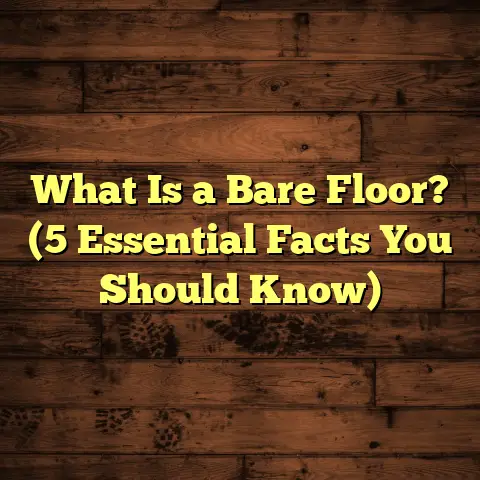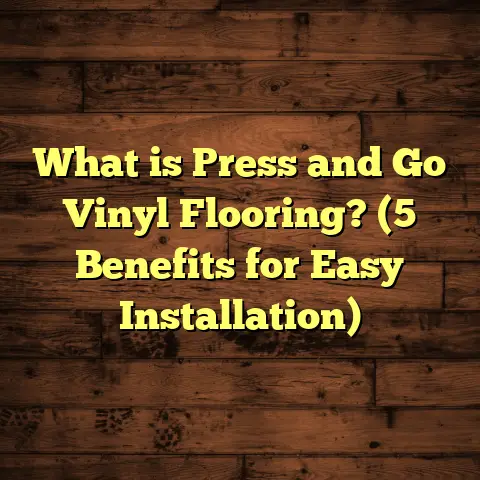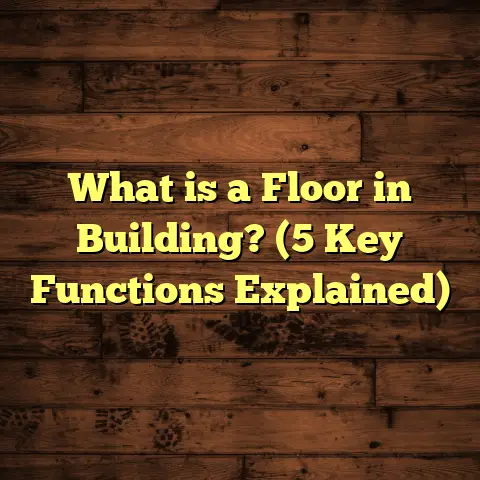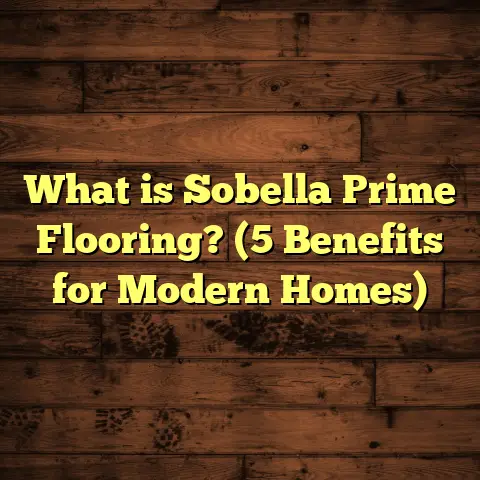What is Laminate Flooring? (5 Key Benefits in Anchorage, AK)
Living in Anchorage, Alaska has shaped many aspects of my everyday life—especially when it comes to the floors beneath my feet. When you’re dealing with months of snow, ice, mud, and fluctuating temperatures, the flooring you choose can make a huge difference in comfort, maintenance, and even your home’s energy efficiency. I’ve had my fair share of trials with different floor types over the years—from carpet that trapped every bit of dirt and moisture to hardwood that scratched too easily and demanded constant care.
That’s why when I first heard about laminate flooring, I was skeptical but curious. Could a floor made mostly from synthetic materials really stand up to Anchorage’s unique challenges? Would it feel cold or cheap? Or would it add warmth and style without breaking the bank?
Over time, I’ve learned that laminate flooring offers a fantastic balance of durability, affordability, and aesthetic appeal. Let me walk you through everything I’ve discovered about laminate flooring—what it really is, why it’s become my go-to flooring choice here in Anchorage, and how it stacks up against other flooring options you might be considering.
Breaking It Down: What Exactly Is Laminate Flooring?
Laminate flooring is a multi-layer synthetic flooring product designed primarily to imitate the look of wood or stone. It’s constructed by bonding several layers together under high pressure. Here’s the typical breakdown:
- Wear Layer: The topmost layer is a transparent, durable coating that protects against scratches, dents, stains, and fading. This layer is usually made of melamine resin or aluminum oxide.
- Design Layer: Beneath the wear layer lies a high-resolution photographic image that mimics natural materials like hardwood grains, marble veining, or tile patterns. Thanks to technological advances in printing, these images are incredibly realistic.
- Core Layer: The thickest part of the plank is typically high-density fiberboard (HDF) or medium-density fiberboard (MDF). This core provides stability and strength.
- Backing Layer: This bottom layer adds moisture resistance and structural support to prevent warping.
This layered design allows laminate flooring to provide a convincing appearance similar to more expensive materials while offering enhanced durability and easier maintenance.
Unlike hardwood floors—which are planks cut from solid wood—laminate is engineered. That means variations in color or pattern come from printed images rather than natural wood grain. But this doesn’t mean laminate looks fake anymore. Modern laminate floors use 3D embossing techniques to create texture that feels like real wood or stone under your feet.
Why Does Laminate Flooring Matter for Life in Anchorage?
Anchorage residents face specific lifestyle challenges when choosing flooring. We get long winters with lots of snow and ice, which means wet boots and muddy paws frequently cross our thresholds. Our homes need floors that can handle moisture without warping or staining. At the same time, we want cozy warmth underfoot during freezing months and something resilient against heavy foot traffic.
I’ve seen plenty of neighbors struggle with traditional hardwood floors warping from moisture or carpets getting stained beyond repair from salt and slush. Laminate flooring addresses many of these pain points by combining toughness with ease of cleaning.
I found this firsthand after installing laminate in my own home’s entryway and kitchen, two of the highest traffic areas prone to moisture exposure. Since then, I haven’t worried about water damage or scratches from snow boots like I did with my previous hardwood floors.
Digging Into 5 Key Benefits of Laminate Flooring in Anchorage
Here are five standout reasons why laminate flooring has become so popular among Anchorage homeowners—including myself.
1. Durability That Withstands Anchorage Weather and Wear
I can’t emphasize enough how important durability is for floors up here. Our cold climate means lots of snow tracked inside during winter months. This brings moisture but also grit from roads that can scratch surfaces.
Laminate’s wear layer makes it highly resistant to scratches, scuffs, dents, and stains. According to testing by the National Wood Flooring Association (NWFA), laminate’s abrasion resistance often surpasses that of solid hardwood floors—even some exotic woods.
When I was researching this before my installation, I came across a study where laminate floors resisted over 3 million cycles of abrasion in laboratory tests before showing wear marks. Hardwood floors typically show wear after about 300,000 cycles. That’s ten times more abrasion resistance!
This means kids running around with shoes on hard floors or pets jumping won’t leave permanent marks easily on laminate.
Moreover, many laminate products now include water-resistant coatings or cores treated with moisture barriers. This helps prevent swelling or warping from minor spills or tracked-in snowmelt—a common problem with traditional hardwood floors here.
I’ve experienced this benefit directly during rainy spring thaws when puddles sneak inside. My laminate floor held up beautifully without any warping or discoloration after repeated exposure to moisture.
2. Cost-Effective Choice Without Sacrificing Quality
One big reason I chose laminate over hardwood was the price. When I priced hardwood flooring for my living room renovation, the material alone was $10-$14 per square foot—and professional installation added another $4-$8 per square foot.
Laminate flooring typically costs between $2 and $5 per square foot including installation. This makes it a great option for homeowners wanting attractive floors without a huge upfront investment.
The cost savings aren’t just from cheaper materials but also from simpler installation methods (more on that later).
A report from HomeAdvisor shows average laminate installation costs around $3-$8 per square foot nationwide, whereas hardwood averages $6-$12 per square foot installed.
For my roughly 1,000 sq ft home area covered, switching to laminate saved me about $6,000 compared to hardwood bids I received.
Despite costing less, laminate doesn’t look cheap anymore. With advanced printing technology and textured finishes that mimic real wood grains or natural stone patterns, laminate gives you style without compromise.
3. Installation Is Manageable—Even for DIYers Like Me
I’m not a professional contractor but enjoy taking on home improvement projects whenever possible. One reason I went with laminate was because it could be installed as a floating floor system using click-lock planks.
This system allows plank edges to snap together without nails, glue, or staples—making installation faster and cleaner.
According to research from the Home Improvement Research Institute (HIRI), laminate floors can be installed up to 50% faster than hardwood requiring nailing or glue because no subfloor preparation beyond leveling is necessary.
My own experience installing about 400 sq ft in two rooms took me a weekend with minimal tools—just a saw for cutting planks and a tapping block for locking boards together.
The floating nature also means laminate can be installed over existing flooring like concrete slabs or vinyl without extensive prep work—a huge plus for many Anchorage homes built on slab foundations.
4. Low Maintenance Fits Busy Anchorage Lifestyles
With our often hectic schedules compounded by winter chores like snow shoveling and tracking in salt and snowmelt, I wanted floors that wouldn’t require constant upkeep.
Laminate floors clean up easily—usually just vacuuming or sweeping daily plus occasional damp mopping with recommended cleaners.
Unlike carpet that traps dirt and allergens requiring deep cleaning every few months or hardwood that may need refinishing after years of wear, laminate stays beautiful with minimal effort.
I noticed my allergy symptoms improved somewhat when switching from carpeted rooms to laminate because dust mites and pet dander don’t embed themselves as much on hard surfaces.
The protective wear layer resists staining too. I’ve spilled coffee and red wine during family dinners but wiped them up quickly without leaving stains—something I never managed on carpet!
5. Huge Variety to Match Any Anchorage Home Style
Anchorage has a mix of architectural styles—from rustic log cabins nestled in the woods to sleek modern condos downtown. One thing I love about laminate is how versatile its designs are.
If you want something warm and traditional like oak or cherry wood grain, it’s available. Or if you prefer cool gray tones with a weathered look reflecting our snowy environment, there are options for that too.
Laminate also comes in tile looks such as slate or ceramic patterns which work well in kitchens and bathrooms, blending style with function.
I personally started with a medium-toned oak finish in my living room but recently swapped out planks in a guest room for a lighter gray wood design during remodeling—something I couldn’t do as easily with hardwood without refinishing.
The Science Behind Laminate’s Strength
I wanted to understand why laminate performs so well under tough conditions like those in Anchorage. A bit of research showed me that its engineering makes all the difference:
- High-Density Fiberboard Core: The HDF core used in quality laminates provides rigidity but also some flexibility to prevent cracking under pressure or temperature changes common here.
- Wear Layer Composition: This top layer often contains aluminum oxide particles—the same material used in industrial abrasives—that make it extremely scratch-resistant.
- Moisture Resistance Treatments: Many manufacturers now incorporate water-resistant resins or sealants into both core and backing layers to help repel moisture penetration.
In one case study published by a flooring industry group, laminated planks exposed to repeated wet-dry cycles showed minimal swelling compared to plywood cores used under hardwood veneers which warped significantly after only a few weeks.
Personal Stories from Around Anchorage: Real Experiences With Laminate Flooring
Beyond my own story, I’ve chatted with several locals who have shared their experiences:
- Mark & Susan (East Anchorage): They installed laminate throughout their basement after water seepage damaged carpeting several times over winter seasons. They reported the floor remains dry and easy to clean despite moisture challenges common in basements here.
- Jennifer (Downtown Condo Owner): Jennifer appreciates how quickly she could install laminate herself above her existing tile floor without costly removal or construction mess—saving both money and time during her busy work schedule.
- The Johnson Family (Suburban Home): With three active kids and two dogs frequently tracking dirt inside after school activities, they praised laminate’s scratch resistance and how little time it takes to maintain compared to their previous hardwood floors.
Comparing Laminate With Other Flooring Options Commonly Used in Anchorage
When thinking about flooring solutions here in Alaska’s largest city, I also examined hardwood, vinyl plank, carpet, and tile options side-by-side with laminate:
| Feature | Laminate | Hardwood | Vinyl Plank | Carpet | Tile |
|---|---|---|---|---|---|
| Cost per sq ft | $2 – $5 | $8 – $14 | $2 – $7 | $1 – $4 | $5 – $15 |
| Installation Ease | Moderate (DIY possible) | Difficult (professional needed) | Easy (DIY friendly) | Easy (DIY friendly) | Difficult (professional needed) |
| Durability | High scratch & stain resistance | Prone to scratches & dents | Water resistant & durable | Stains easily & wears quickly | Very durable but brittle |
| Moisture Resistance | Moderate (water-resistant types) | Poor (warps easily) | Excellent | Poor | Excellent |
| Maintenance | Low | Medium (refinishing needed) | Low | High | Medium |
| Appearance | Realistic wood/tile look | Natural wood grain | Realistic wood/plank look | Soft texture | Natural stone/glass look |
| Comfort Underfoot | Moderate | Warm | Slightly softer than laminate | Very comfortable | Cold/hard |
Hardwood vs Laminate
Hardwood has timeless beauty but struggles with moisture exposure common here unless meticulously maintained and sealed regularly. It also costs significantly more upfront and requires professional installation.
Vinyl Plank vs Laminate
Vinyl plank can handle water better than laminate due to its waterproof core but sometimes lacks the natural feel underfoot that quality laminates provide. Vinyl can be softer but may dent easier under heavy furniture or pet nails.
Carpet vs Laminate
Carpet offers warmth but traps dirt and allergens—a drawback when dealing with wet weather outside your door frequently. It also stains easier and requires more upkeep compared to laminate’s wipe-clean surface.
Tile vs Laminate
Tile is extremely durable and water-resistant but feels cold underfoot unless paired with radiant heating—a costly addition. Tile installation is complex and expensive relative to laminate’s DIY-friendly approach.
Some Anchorage-Specific Tips for Choosing Laminate Flooring
Given our unique environment here are some pointers if you’re considering laminate:
- Pick products labeled “water-resistant” or “moisture barrier” for better performance during wet seasons.
- Use rugs or mats near entrances to reduce tracked-in grit which can cause surface abrasion over time even on laminate floors.
- Consider underlayment options designed for insulation—this helps keep floors warmer against Alaska’s cold subfloors especially during winter months.
- Avoid cheap laminates lacking protective wear layers; investing a bit more upfront pays off long-term with better durability and appearance retention.
How My Experience Changed Over Time
Initially skeptical about synthetic flooring feeling “plasticky,” I was surprised how natural my chosen oak-look laminate felt after installation—both visually and underfoot. Over three winters since then:
- No visible scratches despite regular foot traffic including snow boots tracked inside.
- Minimal maintenance effort compared to previous hardwood or carpeted areas.
- Comfortable warmth combined with ease of cleaning helped reduce household stress related to winter messes.
I recently even replaced some planks in a guest room with a different color pattern without needing professional help—a flexibility uncommon in solid flooring types.
Wrapping Up What You Need To Know About Laminate
If you live in Anchorage like me and want floors that combine beauty with practicality:
- Laminate flooring delivers strong abrasion resistance suitable for snowy winters where grit can cause damage elsewhere.
- It offers affordable costs versus hardwood yet maintains realistic aesthetics thanks to modern printing technologies.
- Installation is straightforward enough for handy DIYers while still providing professional results if desired.
- Easy cleaning fits busy lifestyles coping with outdoor elements constantly tracking inside.
- The range of styles available means you won’t have trouble matching your home’s personality—from rustic warmth to sleek modern looks.
Considering these points along with your budget and lifestyle needs will help you decide if laminate flooring is right for your home here in Alaska’s largest city.
If you want me to provide guidance on specific brands available locally or how to calculate your project cost using tools like FloorTally tailored for Anchorage pricing, just ask! Flooring choices impact your home environment every day—I’m happy to share what worked best for me so you can enjoy your floors worry-free too.





